Pillar 2 - Nutrition
Meerensee Medical Centre
All 4 pillars are essential to your optimal well being and weight management.
A well-balanced diet is the cornerstone of achieving and maintaining a healthy weight. Our approach to weight loss isn’t just about shedding weight; it’s about improving your overall health and well-being.
The Nutritional Advantage: Your Path to Optimal Health
Good nutrition plays a vital and fundamental role in promoting overall good health and well-being. Below are some of the benefits of maintaining a diet that provides essential nutrients in the right proportions:
Healthy Weight Management – Proper nutrition is one pillar in helping you to achieve your goal weight.
Energy and Vitality – A balanced diet provides the necessary energy for your daily activities, helping you stay active and alert throughout the day.
Improved Immune Function – Nutrient-rich foods support a strong immune system, helping your body fight off infections and illnesses more effectively.
Better Digestive Health – A diet rich in fiber, fruits, vegetables, and whole grains supports digestive health by preventing constipation and promoting a healthy gut microbiome.
Heart Health – Proper nutrition can lower the risk of heart disease by reducing blood pressure and cholesterol levels.
Mental Health – Good nutrition can positively impact mental health by providing essential nutrients for brain function.
Improved Skin and Hair – Nutrient-rich foods can contribute to healthier skin & hair.
Enhanced Cognitive Function – Certain nutrients, such as omega-3 fatty acids, antioxidants, and vitamins, are linked to improved cognitive function and a lower risk of age-related cognitive decline.
Better Sleep – Eating the right foods can positively impact sleep quality, helping you get a restful night’s sleep and improving overall sleep patterns.
Improved Mood – Proper nutrition can influence neurotransmitter function, potentially leading to improved mood.
Reduced Inflammation: Anti-inflammatory foods can help reduce chronic inflammation, which is linked to various diseases and conditions.
Enhanced Athletic Performance: Athletes benefit from proper nutrition, as it provides the necessary energy, nutrients, and hydration for peak performance and recovery.
it’s important to remember that good nutrition isn’t just about individual foods or nutrients but rather the overall quality and balance of your diet. A varied, well-rounded diet that includes a wide range of foods from different food groups is key to reaping these benefits and promoting optimal health.
Consulting with a registered dietitian or nutritionist can help you develop a personalized nutrition plan that aligns with your specific health goals and needs.


Trending Diets, are there any benefits?

Trending diets often gain popularity because they promise quick and dramatic results. While some of these diets may have short-term benefits, it’s essential to approach them with caution and consider their long-term implications.
Pros of Trending Diets:
Initial Weight Loss – Many trending diets can lead to rapid weight loss in the short term. This can be motivating for individuals seeking quick results.
Structured Approach – Some trending diets provide a structured meal plan, which can be helpful for people who need specific guidelines for their eating habits.
Cons of Trending Diets:
Lack of Sustainability – Most trending diets are not sustainable in the long run. They often restrict certain food groups or require extreme calorie deficits, making them challenging to maintain over time.
Nutritional Imbalance – Some diets may not provide a well-balanced intake of essential nutrients, potentially leading to nutritional deficiencies and health problems.
Yo-Yo Effect – Rapid weight loss followed by regaining the weight (yo-yo dieting) is a common outcome of many trending diets. This cycle can be detrimental to overall health.
Unsubstantiated Claims – Not all trending diets are based on scientific evidence. Some rely on anecdotal success stories rather than rigorous research.
Potential Health Risks – Extreme diets can pose health risks, such as digestive issues, and metabolic disturbances.
Lack of Individualization: What works for one person may not work for another due to individual differences in metabolism, genetics, and lifestyle.
So what's the best Nutritional plan?
Our Approach, which is a sustainable approach to nutrition.
While trending diets may provide short-term benefits, our goal is to help you achieve long-term success and maintain a healthy lifestyle.
The best nutrition plan is one that is personalized to your individual needs, preferences, and health goals. Below are some key principles that can guide the development of a healthy and balanced nutrition plan:
Variety – Consume a wide variety of foods from all food groups, including fruits, vegetables, whole grains, lean proteins, and healthy fats. Variety ensures you get a broad spectrum of nutrients.
Balance – Aim for a balanced distribution of macronutrients – carbohydrates, proteins, and fats. Balance helps regulate blood sugar, control hunger, and support overall health.
Moderation – Practice portion control and avoid overeating. Eating in moderation prevents excessive calorie intake and helps maintain a healthy weight.
Whole Foods – Focus on whole, minimally processed foods. These are typically higher in nutrients and lower in added sugars, salt, and unhealthy fats.
Fiber – Include high-fiber foods like fruits, vegetables, whole grains, and legumes in your diet. Fiber promotes digestive health, helps control appetite, and stabilizes blood sugar levels.
Hydration – Drink plenty of water throughout the day to stay hydrated. Limit sugary drinks and excessive caffeine.
Limit Added Sugars and Salt – Reduce the consumption of foods and drinks high in added sugars and sodium. These can contribute to health issues like obesity, heart disease, and high blood pressure.
Healthy Fats – Choose sources of healthy fats, such as avocados, nuts, seeds, and olive oil. These fats support heart health and brain function.
Protein Sources – Incorporate a variety of protein sources, including lean meats, poultry, fish, tofu, legumes, and dairy or dairy alternatives.
Portion Control – Be mindful of portion sizes to avoid overeating. Consider using smaller plates and utensils to help control portions.
Meal Timing –Pay attention to meal timing and consider spreading your meals and snacks evenly throughout the day to maintain stable energy levels.
Individualization – Consult with a registered dietitian or nutritionist to create a personalized nutrition plan that aligns with your specific goals, dietary preferences, and any medical conditions or allergies.
Consistency – Consistency is key to long-term success. Establish healthy eating habits that you can maintain over time.
Remember that nutrition is not just about what you eat but also how you eat. Mindful eating, which involves paying attention to your hunger and fullness cues, can be a valuable component of a healthy nutrition plan.
Ultimately, the best nutrition plan is one that you can sustain and enjoy while meeting your health and wellness goals. A qualified nutrition professional can provide expert guidance and support in creating a plan tailored to your needs.
Remember, a healthy diet is one that you can maintain for life, and it should support your overall health and well-being, not just short-term weight loss. It certainly does not cut out entire groups of foods.
Start Your Journey to a Healthier You
Are you ready to take control of your health and embark on a journey toward a healthier, happier you?
Remember, your health is an investment, and we’re here to help you make it a priority. Together, we can achieve your weight loss goals and create a brighter, healthier future.
The Anti-Inflammatory Diet
An anti-inflammatory diet is an eating pattern that emphasizes foods thought to reduce chronic, low-grade inflammation in the body. Inflammation is the immune system’s normal response to injury or infection (causing redness, swelling, and healing). But when inflammation becomes persistent (due to genetics, obesity, stress, or diet), it can damage healthy tissues and contribute to diseases like atherosclerosis, diabetes, Alzheimer’s and certain cancers.
The goal of the anti-inflammatory diet is to encourage foods rich in antioxidants, fiber, and healthy fats that help “interfere with the inflammatory process”, while limiting pro-inflammatory items. For example, Harvard nutrition experts note that such diets emphasize a wide variety of fruits and vegetables, whole grains, legumes, nuts and seeds, and healthy oils (like olive oil) – often including herbal teas, coffee and oily fish rich in omega-3s – while limiting fatty red meats, refined sugars, and excess alcohol. In other words, patterns like the Mediterranean or DASH diets already follow most anti-inflammatory principles.
Anti-inflammatory foods supply phytochemicals and antioxidants (plant compounds) and dietary fiber that help calm the immune response. For example, colorful fruits and vegetables contain flavonoids and carotenoids that neutralize free radicals and block inflammatory pathways. Fiber feeds beneficial gut bacteria and slows glucose absorption, reducing spikes that can trigger inflammation. Omega-3 fats in fish, walnuts or flaxseeds give rise to signaling molecules (resolvins) that dampen inflammation. Many anti-inflammatory foods also contain micronutrients (e.g. vitamins C and E) and spices (like turmeric or ginger) with direct anti-inflammatory effects. By contrast, diets high in ultra-processed junk, refined carbohydrates and saturated fats tend to stimulate inflammatory cytokines.
In sum, an anti-inflammatory diet works by providing building blocks (antioxidants, omega‑3s, fiber) that prevent cellular stress and inhibit chronic immune activation.
Foods to Eat and Avoid
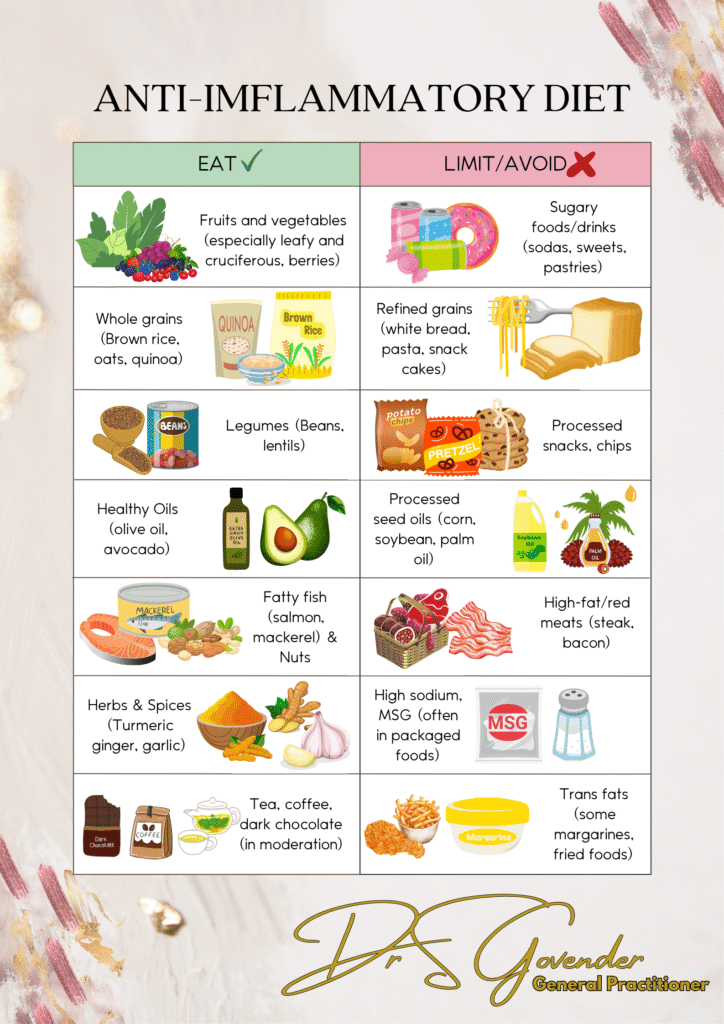
- Foods to include (anti-inflammatory):
- Fruits and vegetables (especially deeply colored or leafy ones). Berries, cherries, citrus fruits, kale, spinach, broccoli, tomatoes, peppers, sweet potatoes, etc. – all provide antioxidants and fiber to neutralize free radicals. For example, fruits and vegetables supply phytochemicals and vitamin C that help “inhibit inflammatory signals”. Aim for a rainbow of produce each day.
- Whole grains and legumes. Brown rice, oats, whole oats, quinoa, barley, plus beans, lentils and chickpeas. These are rich in fiber and slow-burning carbohydrates, preventing blood sugar spikes that can trigger inflammation. They also feed a healthy gut microbiome, which reduces gut permeability and systemic inflammation.
- Healthy fats: Primarily olive oil (extra-virgin) and other monounsaturated oils, plus nuts and seeds (walnuts, almonds, chia, flaxseed). These provide anti-inflammatory omega-3 and omega-6 fats (in a good balance) and vitamin E. Studies show nuts are linked to lower levels of inflammatory markers (e.g. C‑reactive protein) and even lower mortality from inflammation-related diseases.
- Fatty fish and lean proteins: Fish like salmon, mackerel, sardines and tuna are high in omega-3 fats that directly reduce inflammation. (If not eating fish, consider a fish-oil supplement.) Poultry and eggs can be eaten in moderation. Processed red meats should be minimal, and red meat overall limited (perhaps only once a week).
- Herbs, spices and other anti-inflammatory staples: Herbs and spices such as turmeric, ginger, garlic, cinnamon, rosemary, oregano and cayenne are especially beneficial. These contain potent compounds (e.g. curcumin in turmeric) that inhibit inflammatory pathways. Drinking tea or coffee in moderation also provides anti-inflammatory polyphenols. Other anti-inflammatory additions include dark chocolate (in small amounts) and fermented foods (yogurt, kefir, kimchi) for gut health.
- Fruits and vegetables (especially deeply colored or leafy ones). Berries, cherries, citrus fruits, kale, spinach, broccoli, tomatoes, peppers, sweet potatoes, etc. – all provide antioxidants and fiber to neutralize free radicals. For example, fruits and vegetables supply phytochemicals and vitamin C that help “inhibit inflammatory signals”. Aim for a rainbow of produce each day.
- Foods to limit or avoid (pro-inflammatory):
- Refined carbohydrates and sugars: White bread, pastries, sugary drinks, candy and desserts. These cause rapid blood sugar spikes and increase pro-inflammatory molecules. Added sugars (soda, sweets, syrups) should be kept to a minimum.
- Processed and red meats: Sausages, hot dogs, bacon, deli meats and large amounts of red meat. These are high in saturated fat and may contain additives linked to inflammation. The Western diet (rich in processed meats and burgers) is a classic pro-inflammatory pattern.
- Trans fats and high-saturated fats: Avoid foods with hydrogenated oils (some margarines, packaged snacks) and high-fat dairy (cheese, butter in excess). These fats trigger inflammation and raise bad cholesterol. Instead, use olive or canola oil and choose low-fat dairy.
- Highly processed foods: Fast food, chips, snack cakes and similar. These not only contain bad fats, but often refined starches, salt, sugar and additives (like emulsifiers) that can disrupt gut bacteria.
- Excessive alcohol: A moderate amount (e.g. a small glass of red wine occasionally) may be okay, but heavy drinking promotes inflammation and should be avoided. (Even moderate alcohol can interfere with medications if you have certain conditions.)
- Refined carbohydrates and sugars: White bread, pastries, sugary drinks, candy and desserts. These cause rapid blood sugar spikes and increase pro-inflammatory molecules. Added sugars (soda, sweets, syrups) should be kept to a minimum.
The SIBO Diet
What is SIBO?
SIBO stands for Small Intestinal Bacterial Overgrowth. It happens when too many bacteria grow in the small intestine — where they don’t belong — causing bloating, pain, gas, and digestive issues.
Can diet help?
Yes. While diet isn’t a cure, it can reduce symptoms by limiting foods that feed these bacteria. Most people follow a structured diet in 3 phases.
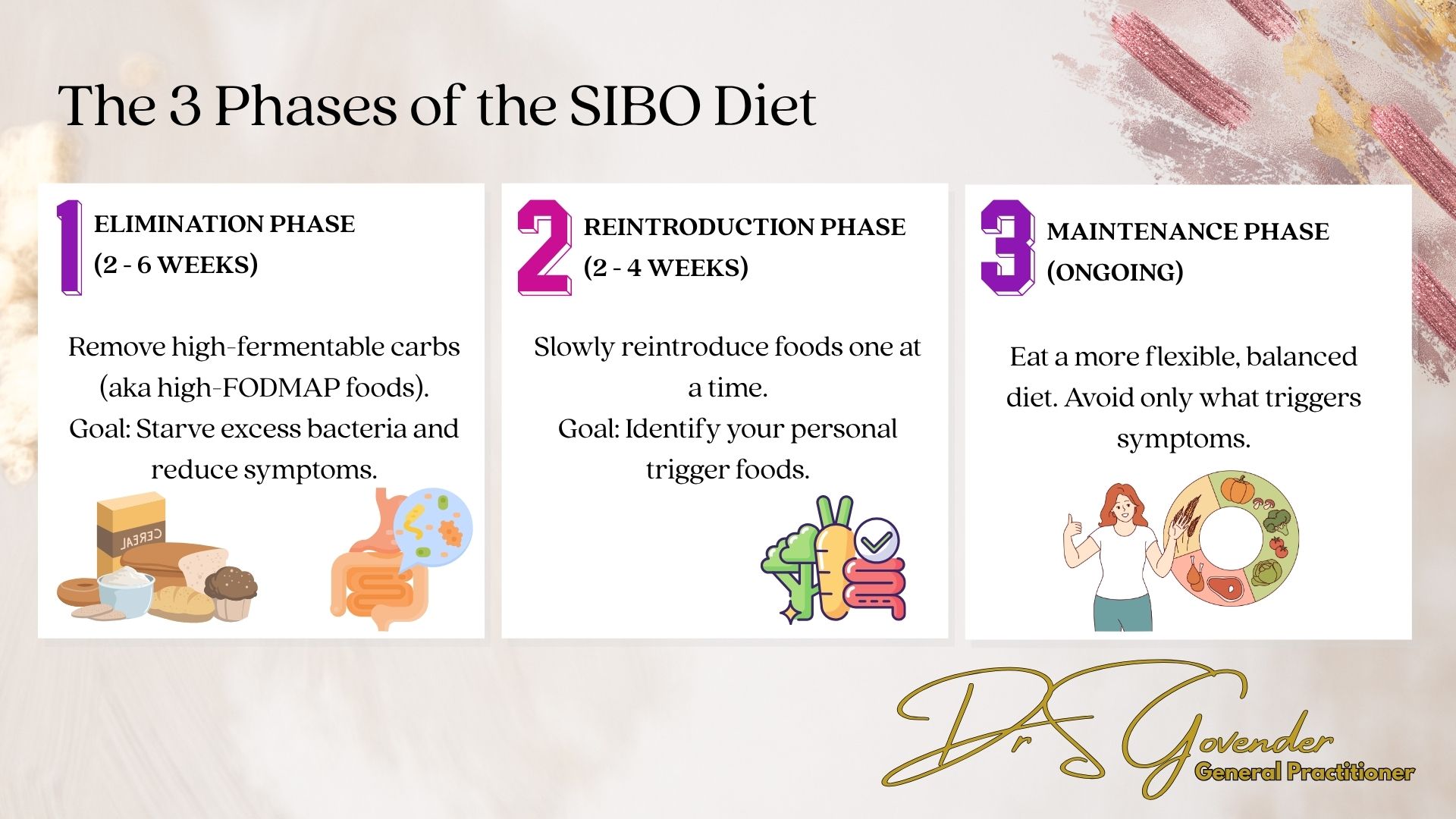
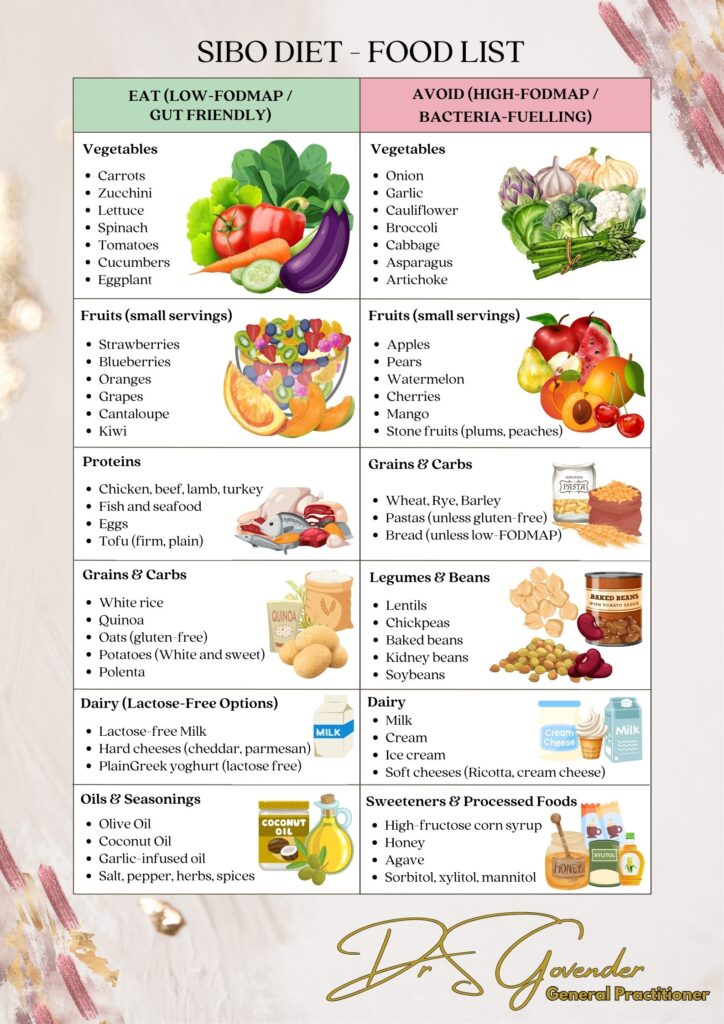
Quick Tips for Success
- Start simple.
Choose 3–4 go-to meals and rotate them. Example:
- Breakfast: Eggs + spinach
- Lunch: Grilled chicken + rice + zucchini
- Dinner: Salmon + potatoes + carrots
- Cook in bulk.
Prep large batches of safe foods to reduce cooking stress. - Read food labels.
Watch for hidden sweeteners and FODMAP ingredients in packaged foods. - Use garlic-infused oil.
It gives flavour without the FODMAPs found in garlic cloves. - Reintroduce carefully.
Test one food at a time every 3–4 days. Track symptoms in a food diary.
6. Don’t go it alone.
Work with a dietitian or doctor — especially during reintroduction
Sample Day (Meal Plan Inspiration)
Breakfast:
Scrambled eggs with spinach + 1 slice gluten-free toast
Lunch:
Grilled chicken breast + rice + sautéed zucchini
Dinner:
Baked salmon + mashed sweet potato + steamed carrots
Snack:
Lactose-free yogurt + blueberries
The Low GI Diet
Understanding the Glycemic Index (GI)
The Glycemic Index (GI) is a valuable tool that ranks foods based on how they affect blood sugar levels. Foods with a high GI are rapidly digested and cause a quick spike in blood sugar, followed by a crash. This rollercoaster effect can lead to increased hunger and cravings, making it challenging to maintain a healthy weight.
In contrast, low GI foods are digested more slowly, resulting in a gradual and steady rise in blood sugar levels. This sustained energy release helps control appetite, reducing the urge to overeat and promoting weight loss.
The Benefits of a Low GI Diet
Stable Blood Sugar – A low GI diet helps regulate blood sugar levels, which can reduce the risk of type 2 diabetes and improve insulin sensitivity.
Weight Management – By curbing cravings and promoting fullness, low GI foods make it easier to control your calorie intake and manage your weight effectively.
Sustained Energy – Low GI foods provide a steady supply of energy, helping you stay active and maintain your energy levels throughout the day.
Heart Health – Incorporating low GI foods into your diet can lower your risk of heart disease by improving cholesterol levels and reducing inflammation.
Improved Mood and Concentration – Stable blood sugar levels can enhance mood, cognitive function, and mental clarity, making it easier to stay focused on your weight loss goals.
Start Your Journey to a Healthier You
Are you ready to take control of your health and embark on a journey toward a healthier, happier you?
Remember, your health is an investment, and we’re here to help you make it a priority. Together, we can achieve your weight loss goals and create a brighter, healthier future.
How is a low GI diet and fiber related?
A low glycemic index (GI) diet and the fiber content of food are closely related because fiber is one of the key factors that influence the GI of a meal. The Glycemic Index measures how quickly carbohydrates in food raise blood sugar levels.
The Importance of Fiber
Dietary fiber is the indigestible part of plant foods.
Fiber has major health benefits
- reduces the risk of heart disease
- improves insulin resistance
- reduces the risk of type 2 diabetes
- prevents constipations
- improved gut health
- weight loss
Dietary fiber has a positive impact on gastrointestinal disorders, including:
- colorectal ulcer
- hiatal hernias
- gastroesophageal reflux disease
- diverticular disease
- hemorrhoids
Dietary fiber is the indigestible part of plant foods.
Fiber has major health benefits
- reduces the risk of heart disease
- improves insulin resistance
- reduces the risk of type 2 diabetes
- prevents constipations
- improved gut health
- weight loss
Dietary fiber has a positive impact on gastrointestinal disorders, including:
Daily Requirements
Females -25 grams per day
Males -38 grams per day
Making it easy
To ensure that you are really buying a high fiber item – read the label – atleast 10g of fiber per 100g
Rice replacements – Barley, Bulgar Wheat, Quinoa
Rolled Oats
Chia Seeds
Start your day with overnight oats containing rolled oats and chia seeds.
Pasta Replacement – Woolworths whole wheat linguine
Bread replacement – Low GI Bread
How does Fiber affect my insulin spikes?
Fiber expands and bulks food in your GI tract, slowing digestion. This can increases satiety and reduce your appetite.
Foods high in fiber also tends to be lower in energy density, meaning they’ll help you feel fuller without consuming excessive calories.
Fiber slows the absorption of carbohydrates, thus reducing the blood glucose spike and the result high insulin spike.
This concept is at the core of why a higher fiber diet is associated with a lower rate of obesity.
There are two types of Fiber
Soluble and Insoluble
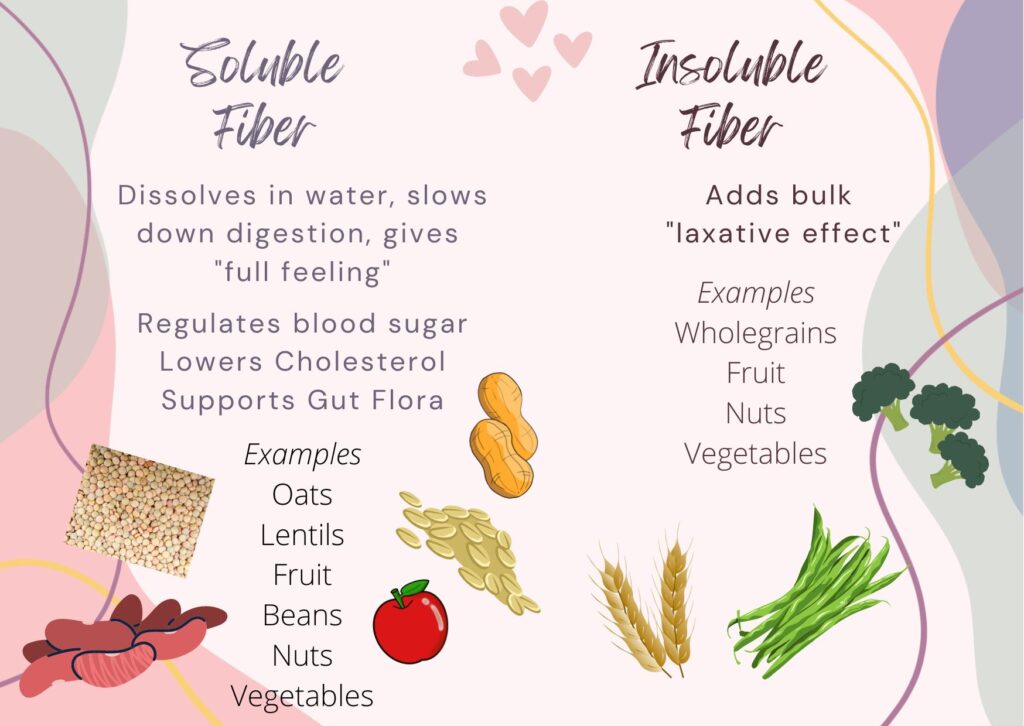
How to increase your fiber intake
- Eat fruits and vegetables with the skins on, as the skins contain lots of fiber
- Add beans or lentils to salads, soups, and side dishes
- Replace white breads and pastas for whole wheat versions
- Aim to eat 4.5 cups of vegetables and 4.5 cups of fruit each day
- If unable to meet the daily requirements, consider using fiber supplements
Carb replacements

What a Meal should Contain

Daily Protein Requirements
80g per kg body weight
An Easy Breakfast option to Kickstart your Day
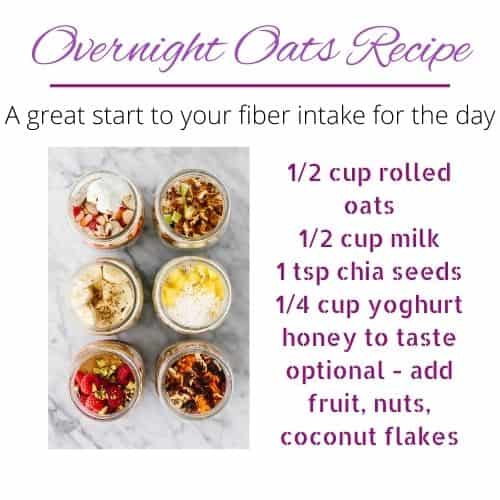
What a Meal should Contain
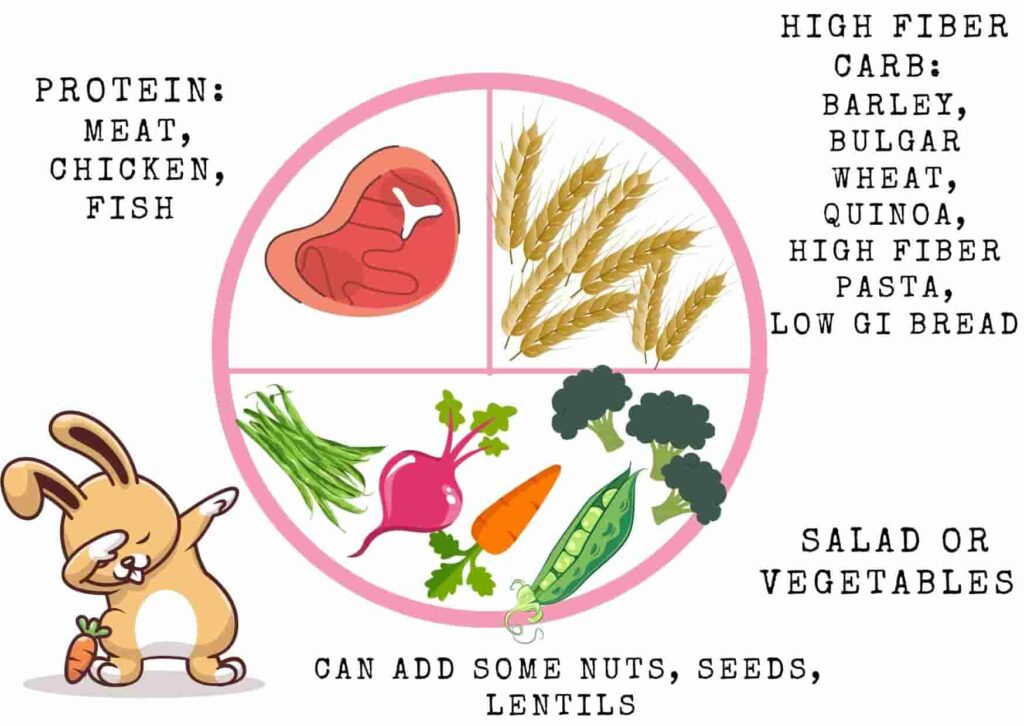
Daily Protein Requirements
80g per kg body weight
Example of a low GI Diet
Creating a personalized monthly nutrition plan requires consideration of your individual dietary preferences, dietary restrictions, and health goals. To provide a general plan, I’ll outline a sample one-month nutrition plan that emphasizes balanced, nutrient-rich meals. However, please keep in mind that it’s crucial to consult with a registered dietitian or nutritionist to create a plan tailored to your specific needs. Here’s a sample plan:
Week 1:
Day 1:
- Breakfast: Greek yogurt with berries and a sprinkle of nuts.
- Lunch: Grilled chicken salad with mixed greens, cherry tomatoes, cucumbers, and balsamic vinaigrette.
- Dinner: Baked salmon with steamed broccoli and quinoa.
- Snack: Carrot sticks with hummus.
Day 2:
- Breakfast: Oatmeal topped with sliced bananas and a drizzle of honey.
- Lunch: Turkey and avocado wrap with whole-grain tortilla.
- Dinner: Stir-fried tofu with mixed vegetables in a teriyaki sauce served over brown rice.
- Snack: Greek yogurt with a handful of almonds.
Day 3:
- Breakfast: Scrambled eggs with spinach and whole-grain toast.
- Lunch: Lentil soup with a side of mixed greens and whole-grain crackers.
- Dinner: Grilled shrimp with roasted asparagus and quinoa.
- Snack: Sliced apples with almond butter.
Day 4:
- Breakfast: Whole-grain waffles topped with strawberries and a dollop of yogurt.
- Lunch: Chickpea salad with diced cucumber, red onion, and feta cheese in a lemon-tahini dressing.
- Dinner: Grilled chicken breast with sweet potato and steamed green beans.
- Snack: Mixed berries and a small piece of dark chocolate.
Day 5:
- Breakfast: Smoothie with spinach, banana, almond milk, and a scoop of protein powder.
- Lunch: Quinoa salad with roasted vegetables, feta cheese, and a lemon-olive oil dressing.
- Dinner: Baked cod with sautéed spinach and brown rice.
- Snack: Sliced cucumbers with tzatziki sauce.
Day 6 and Day 7: Repeat meals from Days 1-5 to maintain variety.
Weeks 2-4: Continue to vary your meals by incorporating a wide range of fruits, vegetables, lean proteins, whole grains, and healthy fats. Try new recipes and experiment with different herbs and spices to keep your meals interesting and flavorful. Consider including occasional treat meals or snacks, but try to maintain portion control.
Remember to drink plenty of water throughout the day and listen to your body’s hunger and fullness cues. Adjust portion sizes and food choices as needed to meet your specific nutritional needs and goals.
This sample plan provides a foundation for a balanced diet, but individual nutritional requirements can vary significantly. Consult with a healthcare professional or registered dietitian to ensure your plan aligns with your unique health and dietary needs. They can also help you make any necessary modifications to address specific goals, such as weight management or dietary restrictions.